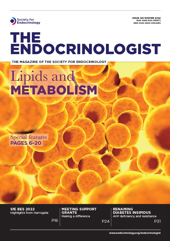Growth is an intrinsic part of energy balance. To fuel growth, there must be enough consumption of food. This is evident to anyone who has been around growing teenagers. However, there is evidence in humans and model species that these links persist across the lifespan and have consequences for metabolic health and disease.1
Understanding of the hypothalamic–pituitary–growth axis began over 100 years ago, with experiments isolating growth hormone (GH) from the pituitary glands of cows, and early investigations into spontaneous mouse mutants date back as far back as the 1920s. The release of GH from the pituitary is regulated in the hypothalamus by means of pulsatile secretion of inhibitory somatostatin from neurones of the periventricular nucleus, and production of the stimulatory GH-releasing hormone from neurones of the arcuate nucleus, reaching the pituitary through the hypophyseal blood portal system.
THE INVOLVEMENT OF EXERCISE
'Understanding how exercise may stimulate food intake will help improve exercise-driven weight loss interventions.'
Stimulation of the growth axis by exercise is something that we explored in the seasonally adapted Siberian hamster (Phodopus sungorus), which has long been purported to be a model for reversible obesity. This dwarf hamster species, native to the Kazakh and Mongolian–Manchurian Steppe, undergoes ‘Dehnel’s phenomenon’, where their body size (and consequently energy requirements) reduces in anticipation of winter.
The physiological changes these hamsters go through include cessation of reproductive capacity, voluntary reduction in food intake, and reduction in body weight (both lean and fat mass), bone mineral density and femur length, organ size (testes/ovaries, liver, kidney, skeletal muscle, adipose tissue depots), in addition to the endearing development of a thick white fur, which even covers the soles of their feet.
Although it had been established that the central thyroid hormone axis is key to this suite of seasonal physiological changes, we demonstrated that the hypothalamic–growth axis, particularly the somatostatin neurones of the arcuate nucleus, is probably key to driving these growth changes.2 Similarly, growth can be stimulated in these ‘winter-adapted’ hamsters with voluntary exercise on a running wheel; they gain lean and fat mass in equal proportion which, again, we attributed to stimulation of the growth axis.3
This could be a model for what happens in human physiology in response to an exercise intervention which, without accompanying dietary intervention, is often followed by weight gain rather than the expected loss. Therefore, understanding how exercise may stimulate food intake will help improve exercise-driven weight loss interventions.
LINKS TO NUTRITION
In more recent work, we again found that arcuate nucleus somatostatin may play a role in small body size. There is proportionately lower body fat and food intake in mice with a mutation in the ZFHX3 transcription factor, which appears to model a similar protein-altering mutation in a human population.4 This suggests that these arcuate nucleus somatostatin neurones, not previously considered important in the regulation of GH secretion, may have a conserved role in long term growth and energy balance.
GH is a ‘fasting hormone’, released mainly during the night in humans. It helps regulate glucose levels by stimulating lipolysis to increase free fatty acids in circulation and drive lipid metabolism. Selective loss of GH receptor in adipose tissue leads to increased fat mass in mouse genetic models,5 indicating direct action at the tissue. Results are, however, less clear for insulin-like growth factor-1, probably due to the limitations of selective genetic manipulations.
Hypoglycaemia probably influences the growth axis by stimulating neuropeptide Y (NPY) neurones of the hypothalamus which, while NPY is predominantly known for its appetite-stimulating action, also stimulates upregulation of the positive arm of the growth axis.6
Signals from the periphery, such as glucose, other nutrients, vitamins and hormones, reach the brain through ‘leaky’ regions in the blood brain barrier – the circumventricular organs such as the median eminence, and specialised cells called tanycytes that can relay nutrient signals from the cerebrospinal fluid to the hypothalamus.7 This makes these specialised cells, which even contain taste receptors,8 key for relaying nutrient signals to influence energy balance in the brain, and allows for regions close to these ‘leaky’ sites to be influenced by peripheral nutritional status. The recent discovery of novel blood portal systems9 means that brain regions that we didn’t previously consider may be able to respond to such nutrient signals.
Interestingly, interactions with macronutrient preference in the diet have been identified in rats who had GH-releasing hormone or somatostatin manipulated in the hypothalamus. A human genome-wide association study identified a variant in the somatostatin SST2 receptor associated with protein content in the diet and body mass index.10 This link between dietary protein and growth axis activity makes sense on an intuitive level, and suggests that links between the growth axis and eating behaviour may be even more complex than simply responding to glucose status.
Going forward, it is exciting to consider that systems studied for over a century still have more to tell us about how the brain integrates peripheral signals, whether from diet, exercise or the environment, to drive growth, eating behaviour and glucose and lipid metabolism. Understanding these systems will lead to better interventions to regulate body weight and tackle metabolic disease.
Rebecca Dumbell
Senior Lecturer in Pharmacology, Department of Biosciences, School of Science and Technology, Nottingham Trent University
REFERENCES
1. Dumbell R 2022 Journal of Neuroendocrinology 34 e13133.
2. Dumbell RA et al. 2015 Journal of Neuroendocrinology 27 588–599.
3. Dumbell R et al. 2017 Journal of Neuroendocrinology 29 doi: 10.1111/jne.12448.
4. Nolan PM et al. 2022 bioRχiv doi: 10.1101/2022.05.25.493441.
5. List EO et al. 2019 Endocrinology 160 68–80.
6. Steyn FJ 2015 Journal of Neuroendocrinology 27 577–587.
7. Elizondo-Vega RJ et al. 2019 Frontiers in Endocrinology 10 244.
8. Benford H et al. 2017 Glia 65 773–789.
9. Yao Y et al. 2021 Nature Communications 12 5643.
10. Sotos-Prieto M et al. 2010 Annals of Nutrition & Metabolism 57 124–131.






